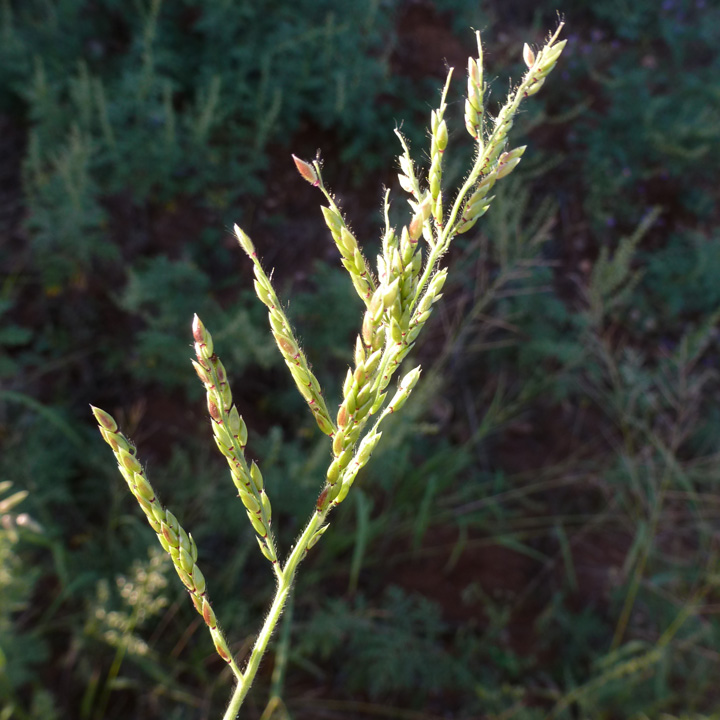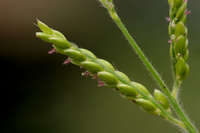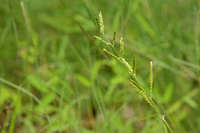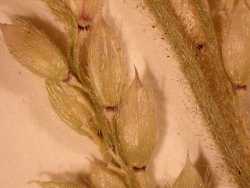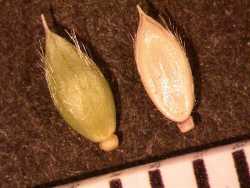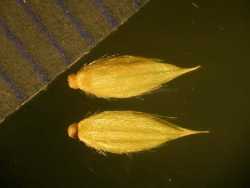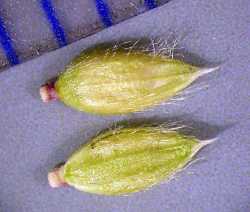Plants annual; cespitose. Culms 30-120 cm, erect or decumbent, sometimes rooting at the lower nodes; internodes glabrous or with scattered hairs; nodes glabrous or pilose. Sheaths sometimes conspicuously inflated, glabrous or pubescent; ligules 0.2-1.2 mm; blades 5-12(18) cm long, (2)5-12(16) mm wide, linear, flat or folded, straight or lax, glabrous or sparsely pubescent adaxially. Panicles 7-16 cm long, 1-6 cm wide, loosely contracted; rachises scabrous or hairy; branches 5-20, 1-5 cm long, 0.4-0.6 mm wide, appressed to divergent, pubescent, sometimes setose, not winged, with 20-36 spikelets, spikelets mostly in unequally pedicellate pairs, solitary distally; pedicels 0.1-1 mm, hairy. Spikelets 3.8-5(6) mm long, 1.1-1.4 mm wide, lanceolate to ovate. Lower glumes absent; upper glumes equaling the lower lemmas, lanceolate to ovate, hairy, 5(7)-veined, acuminate to acute, unawned or awned, awns to 1.2 mm; lower lemmas 3.6-5 mm long, 1.1-1.4 mm wide, lanceolate to ovate, setose, 5(7)-veined, acuminate to acute, unawned; lower paleas absent; anthers absent; upper lemmas 2.3-3.3 mm, 0.7-0.9 times as long as the lower lemmas, indurate, elliptic, rounded, 5-veined, awned, the awns 0.1-0.3 mm; upper paleas indurate, blunt, rugose. 2n = 36.
Eriochloa acuminata is native to the southern United States and northern Mexico, but has become established outside this region. It may hybridize with E. lemmonii, from which it differs in its lack of lower paleas, upper glumes and lower lemmas with level veins, and narrower, glabrous or sparsely pubescent leaf blades.
There are two varieties of Eriochloa acuminata, differing as shown in the key below.
Annuals, Terrestrial, not aquatic, Stems nodes swollen or brittle, Stems erect or ascending, Stems geniculate, decumbent, or lax, sometimes rooting at nodes, Stems caespitose, tufted, or clustered, Stems terete, round in cross section, or polygonal, Stem nodes bearded or hairy, Stem internodes hollow, Stems with inflorescence less than 1 m tall, Stems, culms, or scapes exceeding basal leaves, Leaves mostly basal, below middle of stem, Leaves conspicuously 2-ranked, distichous, Leaves sheathing at base, Leaf sheath mostly open, or loose, Leaf sheath smooth, glabrous, Leaf sheath hairy, hispid or prickly, Leaf sheath and blade differentiated, Leaf blades linear, Leaf blades 2-10 mm wide, Leaf blades mostly flat, Leaf blade margins folded, involute, or conduplicate, Leaf blades mostly glabrous, Ligule present, Ligule a fringed, ci liate, or lobed membrane, Ligule a fringe of hairs, Inflorescence terminal, Inflorescence an open panicle, openly paniculate, branches spreading, Inflorescence a contracted panicle, narrowly paniculate, branches appressed or ascending, Inflorescence solitary, with 1 spike, fascicle, glomerule, head, or cluster per stem or culm, Inflorescence a panicle with narrowly racemose or spicate branches, Inflorescence branches more than 10 to numerous, Flowers bisexual, Spikelets pedicellate, Spikelets dorsally compressed or terete, Spikelet less than 3 mm wide, Spikelets with 1 fertile floret, Spikelets with 2 florets, Spikelet with 1 fertile floret and 1-2 sterile florets, Spikelets solitary at rachis nodes, Spikelets paired at rachis nodes, Spikelets all alike and fertille, Spikelets bisexual, Spikelets disarticulating below the glumes, Spikelets secund, in rows on one side of rachis, Rachilla or pedicel glabrous, Glumes present, empty bracts, Glumes 1 clearly present, the other g reatly reduced or absent, Glumes distinctly unequal, Glumes equal to or longer than adjacent lemma, Glumes 3 nerved, Glumes 4-7 nerved, Lemmas thin, chartaceous, hyaline, cartilaginous, or membranous, Lemma coriaceous, firmer or thicker in texture than the glumes, Lemma becoming indurate, enclosing palea and caryopsis, Lemma 5-7 nerved, Lemma glabrous, Lemma rugose, with cross wrinkles, or roughened, Lemma apex truncate, rounded, or obtuse, Lemma apex acute or acuminate, Lemma awnless, Lemma mucronate, very shortly beaked or awned, less than 1-2 mm, Lemma margins inrolled, tightly covering palea and caryopsis, Lemma straight, Palea present, well developed, Palea
Common Name: tapertip cupgrass
Duration: Annual
Nativity: Native
Lifeform: Graminoid
General: Annual grass, stems 20-100 cm, long, weak, and usually decumbent or geniculate below, sometimes rooting at lower nodes; herbage can be glabrous to hirsute.
Vegetative: Blades bright green, glabrous or rarely thinly pubescent, thin, 3-10 mm broad; ligule of soft hairs; sheaths glabrous or occasionally hirsute.
Inflorescence: Panicle 6-18 cm long, with 5-20 appressed or erect-spreading branches; the branches 1-5 cm long, widely spaced along the main axis, dense with 20-36 appressed spikelets, mostly in unequally pedicellate pairs; inflorescence branches and pedicels flattened or angular, densely pubescent with hairs to 4 mm long; spikelets 4-5 mm long, with 2 florets, lower florets usually sterile, upper florets bisexual; first glume absent; second glume and sterile lemma abruptly acuminate, mostly 3-4 mm long, appressed-pubescent; fertile lemma oblong, finely reticulate, abruptly cuspidate at the apex.
Ecology: Found in sandy washes and depressions, along streams, and on disturbed soils from 2,500-5,500 ft (762-1676 m); flowers August-October.
Distribution: Much of the southern half of the US; from CA east to MD; south to s MEX.
Notes: Eriochloas are grasses with hard, single-seeded, pointy-tipped spikelets resembling panicum; this species is an annual with hairy infertile lemmas and glumes; no awns; and small reddish cupules at the base of each spikelet which are left behind after spikelets fall. FNA recognizes 2 varieties: E. acuminata var. minor has spikelets with acute tips, while E. acuminata var. acuminata has spikelets with long-acuminate tips which can terminate in a short awn.
Ethnobotany: Unknown
Etymology: Eriochloa from Greek erion, wool, and chloe or chloa, grass, while acuminata means having a long tapering point.
Synonyms: None
Editor: SBuckley 2010, FSCoburn 2014, AHazelton 2015


